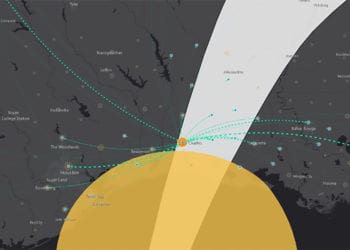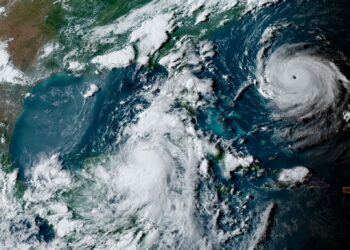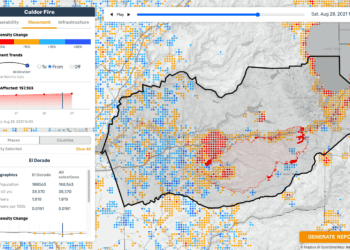KEY POINTS
- The area of displacement from Calcasieu post-Laura stretched in all directions from the epicenter, principally to Orleans Parish and Baton Rouge in the east, and to Houston in the West.
- Rates of return to Calcasieu have been relatively slow, with only ⅓ of displaced persons having returned 25 days post-storm.
- Displacement and return have been disproportionately gendered, with greater numbers of women being displaced and also returning at higher rates than men
- Shelter usage patterns show significantly lower utilization after Laura in the past
The 2020 hurricane season has been unusually active, with 23 named storms as of September 24th, six greater than the previous annual record set in 2005.
As Hurricane Sally arrived on the Gulf Coast across the Florida panhandle and into Mississippi and Alabama, people once again had to evacuate at-risk locations and seek safety from the storm in the midst of a pandemic. Hurricane Laura landed in Louisiana and Texas less than three weeks previously, and some evacuees from that storm were still staying in temporary shelters, hotels, and other types of short-term housing. The succession of events and their potential geographic overlap raised serious concerns about safe evacuation and long term displacement. Risks remain high for similar events throughout the rest of this year, making reflection and learning from the recent past a particular imperative now.
Where Did People Go?
Data from Facebook and Camber Systems highlights patterns of movement as people moved to shelter from the hurricanes that landed on the Gulf Coast in the early part of September.
First, we can see the estimated change in the population of devices from Facebook data. The difference in densities between counties can be seen by comparing the percentage change of the population with an estimated absolute change extrapolated using the American Community Survey (ACS) data from the US Census.


Cameron Parish, in the southwest corner of the state, is highlighted red in both pictures, indicating a significant percentage change of people as well as a significant absolute change. But just south, Jefferson Parish, is not red in absolute change, as it has a far lower density of people.
The overall pattern of dispersal from Calcasieu Parish in the face of Laura is shown in the below animation. Calcasieu Parish is useful to focus on given that it hosts the city of Lake Charles, which bore the brunt of the storm.

According to reports from the Red Cross over 8,000 homes were destroyed or badly damaged, the majority located in the Lake Charles area. Throughout the region, the locations with the greatest reduction in population as of September 7th (the last date of Facebook mobility data available)ranged from Harris County, TX on the highest end through the following set of cities across southern Louisiana.
| Date | FIPS | County | Estimated Pop Change |
|---|---|---|---|
| 9/7/2020 | 48201 | Harris | -12734 |
| 9/7/2020 | 22019 | Calcasieu | -3071 |
| 9/7/2020 | 22033 | East Baton Rouge | -1922 |
| 9/7/2020 | 22051 | Jefferson | -1806 |
| 9/7/2020 | 22071 | Orleans | -1269 |
Gender and Displacement
According to long-term displacement data from Facebook, population displacement from Calcasieu Parish has been gender skewed to a degree that demands further investigation. Although the overall Facebook data sample appears to be skewed towards women, with the user base in the region, those with location services enabled, being composed of 56.2% women, the proportion of persons displaced from Calcasieu Parish was tilted to an even greater degree towards women. Whereas 55.1% of all displaced persons in the region were female, according to Facebook, as of September 10th, 2020 that number rose to 63.3% for women from Calcasieu, a difference of 8.2%.
The proportion of returnees was also skewed towards greater proportions of women. As of September 20th 33% of the population displaced from Calcasieu had returned. However the rate for women was much higher at 37% as compared with 28% for men. The rate of return has also increased steadily for women relative to men over the past 10 days. These gender differences in rates of return potentially indicate greater challenges for women with longer term displacement.

Reasons for the gender disparities in displacement are likely due to underlying social vulnerabilities in the area. For example, the rate of households headed by a single parent in Calcasieu is more than three times greater for women as compared to men, with 10.5% of family households being headed by a single female parent as opposed to 2.8% for men. These types of gendered household disparities tend to reflect underlying income differences as well.
Shelter Utilization
Historically, the American Red Cross and community partners have provided shelter for tens of thousands of people during major hurricanes. This year, however, the ongoing COVID-19 pandemic has fundamentally altered the process of evacuation and sheltering. Response agencies are now operating smaller shelters, conducting COVID-19 screening, and working to house evacuees in hotels, where they can self-isolate, rather than in mass shelters. Many evacuees have been also choosing to avoid shelters altogether, in some cases choosing to sleep in vehicles instead.
While past hurricanes in the region have resulted in many thousands of people staying in shelters at the height of a storm, usage numbers peaked at a few hundred per night following Hurricane Laura and quickly downtrended. Most of the people who would have been expected to use shelters during a major storm chose not to do so during and after Hurricane Laura. Based on this, it seemed likely that evacuees from Hurricane Sally would also use shelters far less than they would have been expected to in years past.
Epidemiological modeling shows that hurricane evacuations can impact the spread of COVID-19 as evacuees are displaced from their homes. In seeing the spread of people away from the hurricanes and that people had yet to return home from Laura before Sally hit, the long-term impact of transmission from evacuees needs to be studied. The information here, especially that showing where people went – and then stayed – is important for future planning. There are nearly impossible tradeoffs to be made here, given that evacuation from hurricanes is necessary – but, appropriate shelter planning can potentially reduce the spread of COVID-19 across counties.


